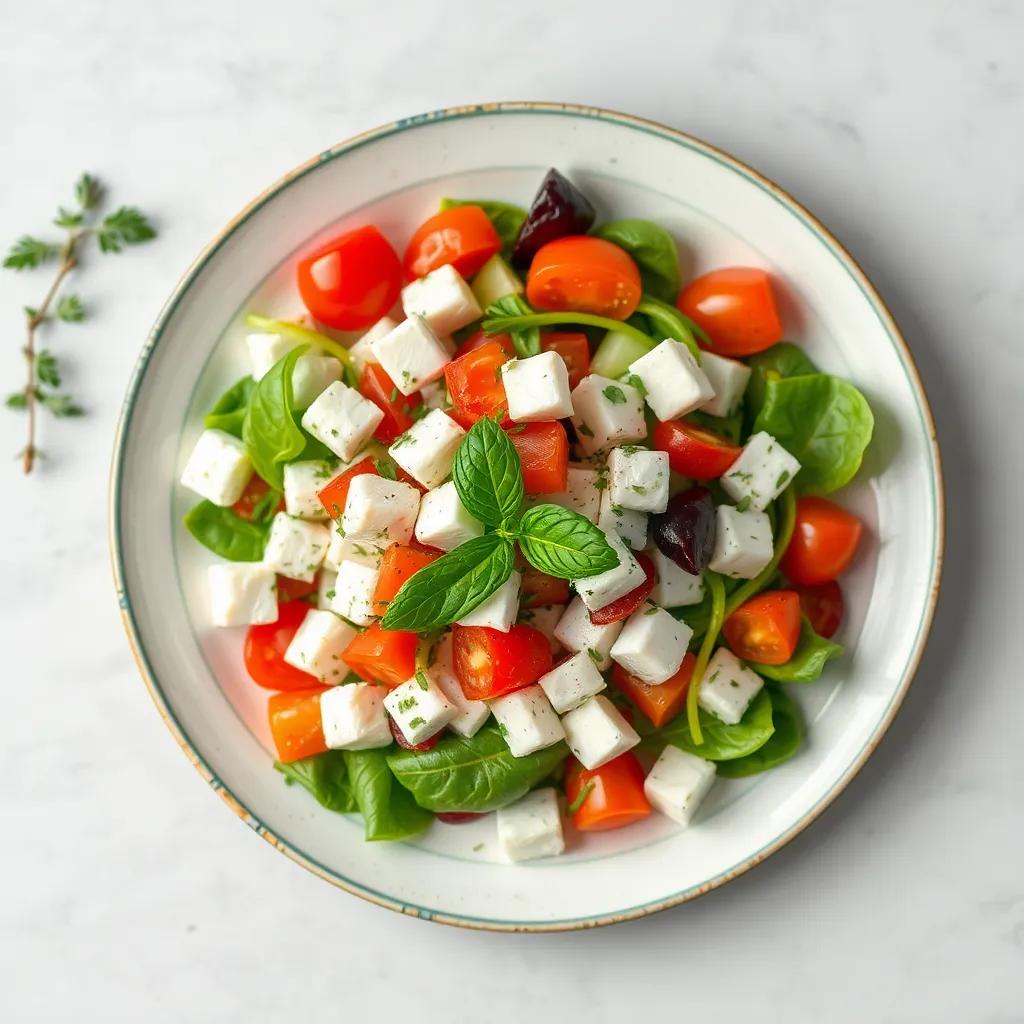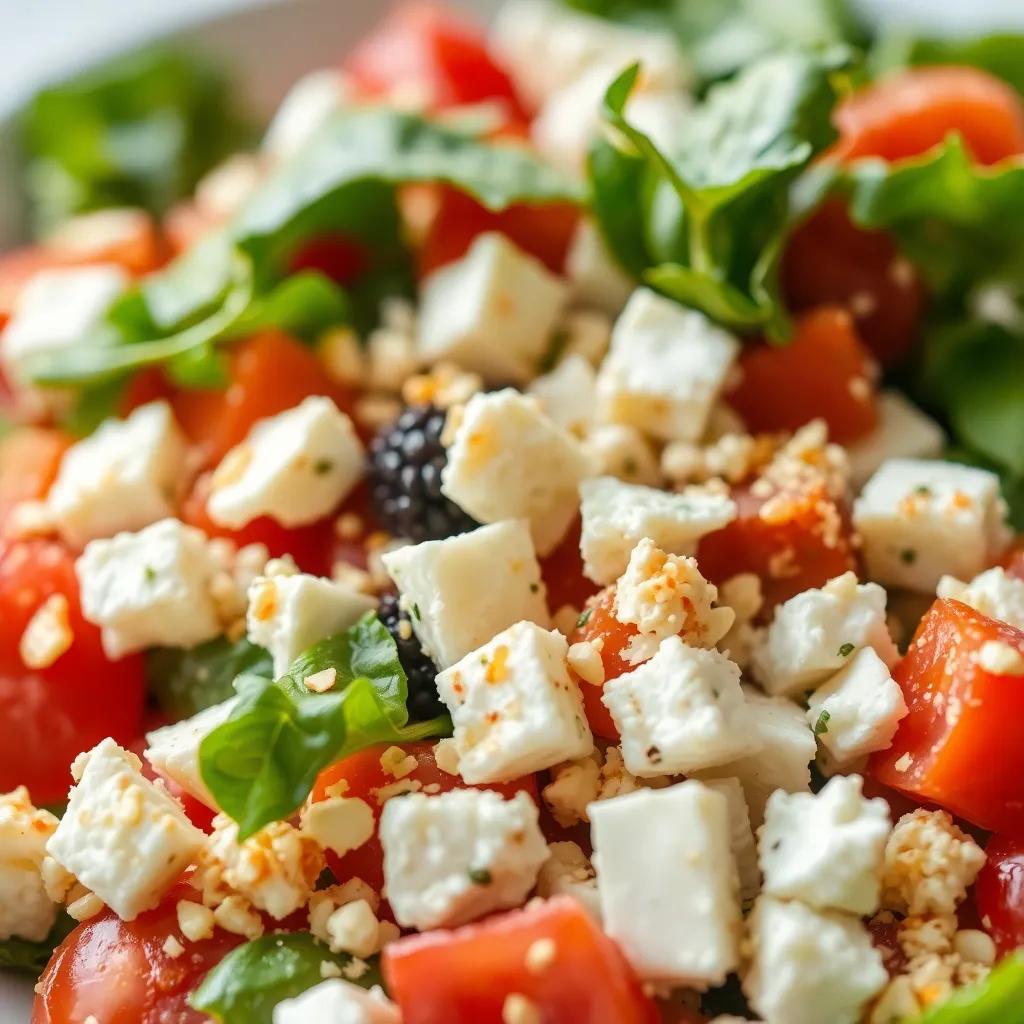The Ultimate Easy Greek Salad Recipe: Fresh, Gluten-Free & Vibrant

The Ultimate Easy Greek Salad Recipe: Fresh, Gluten-Free & Vibrant
🌍 Cuisine: Greek
⚙️ Difficulty: Easy
Ingredients
Nutrition Facts
~180
Instructions
- Wash and chop the Romaine lettuce into bite-sized pieces. Place in a large salad bowl.
- Chop the tomatoes into chunks and add them to the bowl.
- Peel, seed, and slice the cucumber; add to the salad bowl.
- Thinly slice the red onion and add it to the mixture.
- Add the pitted Kalamata olives to the bowl.
- In a small bowl, whisk together the extra-virgin olive oil, red wine vinegar, dried oregano, salt, and pepper until well combined.
- Pour the dressing evenly over the salad ingredients.
- Gently toss all ingredients together to combine and coat with the dressing evenly.
- Sprinkle crumbled feta cheese over the top of the salad.
- Garnish with fresh parsley or mint leaves if desired.
- Serve immediately or refrigerate for up to 1 hour to allow flavors to meld.
- Before serving, gently toss again to redistribute dressing and ingredients.
Serving Suggestions
- Serve as a refreshing side dish alongside grilled chicken or fish.
- Enjoy it as a light lunch with warm pita bread on the side.
- Add some grilled shrimp or falafel to make it a more filling meal.
- Pair with a chilled glass of white wine or ouzo for an authentic Greek experience.
- Top with a squeeze of fresh lemon juice for an extra zesty finish.
- Use as a topping for bruschetta or flatbread for a Mediterranean snack.
- Mix in some quinoa or chickpeas to add protein and extra texture.
Table of Contents

Intro
There’s something wonderfully satisfying about a dish that is as effortless to prepare as it is delightful to eat, and this Ultimate Easy Greek Salad fits that description perfectly. Bursting with freshness and color, it serves as a vibrant centerpiece for any meal—whether it’s a sunny weekday lunch, a casual weekend barbecue, or a light side for a Mediterranean-inspired dinner. Its naturally gluten-free nature makes it an inviting choice for guests with dietary restrictions, and its no-cook simplicity means you can have it ready in just minutes without losing any of the bold, authentic flavors.
What makes this salad truly exciting is how it manages to bring together crisp textures and lively tastes in perfect harmony. It’s an ideal way to enjoy seasonal produce at its peak, creating a dish that feels both nourishing and indulgent. Plus, its versatility shines when you want to mix things up—pair it with grilled seafood for a beachy vibe or serve it alongside your favorite dips and breads for a vibrant mezze spread. This is more than just a salad; it’s your new go-to for fresh, fuss-free dining that always impresses.
Ingredient Notes
When it comes to nailing the authentic flavor of a Greek salad, a few standout ingredients make all the difference. Here’s a closer look at what to keep in mind when selecting these essentials, along with some handy tips if you need alternatives.
Kalamata Olives
These deep purple olives aren’t just a pretty garnish—they’re the heartbeat of the salad’s briny, tangy character. When choosing Kalamata olives, look for ones labeled “PDO” (Protected Designation of Origin) for guaranteed authenticity. They should be plump, firm, and free of excess oil or bitterness. If fresh Kalamatas are hard to find, other black olives can work in a pinch, but avoid canned varieties soaked in heavy salt brine, as they can overpower the dish.
Extra-Virgin Olive Oil
Greek salad thrives on the rich, fruity notes of a high-quality extra-virgin olive oil. This ingredient acts as the glue that brings all the flavors together, offering a silky texture and subtle peppery finish. Opt for a cold-pressed, early harvest olive oil if you can—it’s vibrant and less bitter. When tasting the oil, it should sing with freshness, not taste greasy or rancid. If unavailable, a mild, good-quality olive oil is fine, but avoid vegetable oils, which dull the flavor.
Feta Cheese
Feta gives the salad its creamy, salty punch. Traditional Greek feta is made from sheep’s or goat’s milk, and its crumbly, tangy profile contrasts beautifully with crisp veggies. When purchasing, check for feta packaged in brine—this keeps it moist and flavorful. If you want a dairy-free or vegan option, try crumbled firm tofu seasoned with lemon juice and a pinch of sea salt to mimic feta’s tang.
Red Wine Vinegar
This ingredient brightens the salad with a sharp, fruity acidity, balancing the richness of the olive oil and feta. Look for a good-quality red wine vinegar that isn’t overly sharp or metallic. Aged varieties tend to have a mellower, deeper flavor. As an alternative, you can use fresh lemon juice for a citrusy twist, which also pairs well with the Mediterranean theme.
By paying attention to these key players, you’re ensuring every bite of your Greek salad bursts with freshness, authenticity, and balance—simple upgrades that elevate your easy salad into a truly memorable dish.
Tips & Variations
To elevate your Ultimate Easy Greek Salad to the next level, here are some pro tips and creative twists that let you tailor this fresh, vibrant dish to your taste and dietary needs.
Pro Tips for Perfect Balance:
- Chill your ingredients beforehand. Keeping your vegetables and feta cool preserves their crispness and bright flavors, making the salad extra refreshing—ideal for warm weather.
- Use a light hand when tossing. Gently fold the salad to avoid bruising delicate ingredients like tomatoes and feta. This keeps textures distinct rather than mushy.
- Let flavors meld briefly. While it’s best enjoyed fresh, letting the salad rest for 20-30 minutes in the fridge allows the dressing to soak into the veggies without compromising crunch.
Customizations to Suit Your Style:
- Go beyond Romaine: Swap or mix in other greens like arugula, baby spinach, or butter lettuce to add new flavor notes and textures. For a heartier bite, even kale or Swiss chard work well if you massage them lightly with dressing first.
- Add a protein boost: Turn this salad into a complete meal by tossing in grilled chicken strips, seared halloumi, or even canned chickpeas for plant-based protein. Grilled shrimp or falafel cubes also complement the Mediterranean flavors beautifully.
- Brighten with fresh herbs: While parsley or mint are classic, try adding fresh dill, oregano, or basil leaves for a fragrant herbal twist that layers additional complexity.
Common Ingredient Swaps:
- Feta alternatives: For dairy-free or vegan diets, crumbled marinated tofu or almond-based feta can mimic the tang and texture well. Nutritional yeast mixed with lemon juice can also lend a cheesy note in a pinch.
- Olives options: If Kalamata olives aren’t available, Castelvetrano or Niçoise olives offer milder, buttery alternatives. Just reduce added salt accordingly since some olives vary in brininess.
- Vinegar substitutions: Lemon juice is an elegant substitute for red wine vinegar, injecting a bright citrus dimension that pairs exceptionally well in summer versions. Apple cider vinegar can be a mellow backup choice.
Make It Your Own:
This Greek salad is a wonderfully adaptable canvas. Whether you prefer a heartier meal, a vegan twist, or a palate refreshed with unexpected herbs and dressings, there’s room to experiment without straying from its classic roots. Start simple, then gradually add your signature touch—be it a sprinkle of toasted pine nuts, sun-dried tomatoes, or a pinch of smoked paprika in the dressing—to suit your mood or occasion.
Embrace these variations and tips to confidently bring this gluten-free, fresh salad to your table again and again, each time with a new flourish that suits your lifestyle and taste buds.
Leftovers & Storage
Leftovers from The Ultimate Easy Greek Salad can be a bit of a delicate affair due to its fresh, crisp vegetables and vibrant dressing, but with the right storage approach, you can enjoy that Mediterranean magic even the next day. Because this salad is best eaten fresh to preserve its texture and flavors, keeping leftovers properly stored will help maintain as much freshness as possible.
To store leftover Greek salad, transfer it to an airtight container to prevent the ingredients from drying out or absorbing fridge odors. Glass containers with tight-fitting lids are ideal, as they won’t retain flavors and allow you to see the salad at a glance. Avoid plastic bags or loose containers that might crush the tender tomatoes or wilt the lettuce unevenly.
Because the salad contains ingredients like lettuce, cucumber, and tomato—which tend to release water over time—and is dressed with olive oil and vinegar, it’s recommended to keep it refrigerated and consume within 24 hours for best quality. After a day, the texture of the greens may soften, and the salad could become soggy, though the flavors will still be pleasantly tangy and inviting.
If you anticipate leftovers or want to meal prep, consider storing the salad components separately: chop the vegetables and olives and keep the feta on the side, then whisk the dressing separately in a small jar. Assemble just before eating to preserve the crispness and avoid watery wilt. This method works especially well if prepping for lunches or busy weeknights.
Freezing is not recommended for this salad since the fresh vegetables and cheese lose their texture and flavor once thawed. Instead, aim to enjoy all servings fresh or within the first day after preparation.
For packing the salad to-go, such as for work or picnics, keep the dressing separate until ready to eat. Use a leakproof container or jar, and pack sturdy greens like Romaine (which holds up better than more delicate lettuces) to help the salad stay crisp longer.
In summary, enjoy this vibrant Greek salad at its freshest by eating it soon after making, using airtight containers for storage, and when possible, storing components separately to keep flavors bright and textures crisp. This way, leftovers won’t lose their charm and can still bring a taste of Greece to your table the next day.
Behind the Recipe
Greek salad, or “Horiatiki” as it’s known in Greece, is much more than just a medley of fresh vegetables tossed with cheese and olives—it’s a vibrant snapshot of Greek life and tradition. Rooted in the sun-drenched countryside, this salad reflects the simple, wholesome ingredients that have long defined Mediterranean eating: fresh produce, good olive oil, and bold flavors that celebrate the land and sea.
The origins of Greek salad are humble and deeply tied to rural farmers and fishermen who relied on whatever was fresh and seasonal at the time—ripe tomatoes picked straight from the vine, crisp cucumbers, pungent onions, and the iconic salty punch of Kalamata olives and feta cheese made from local sheep or goat’s milk. Over time, this unassuming dish became a symbol of communal sharing and hospitality, often enjoyed outdoors during family gatherings or lively celebrations around a table strewn with other mezze dishes.
For many home cooks and travelers alike, this salad is a taste of summer in a bowl—light enough to refresh on a hot day but satisfying through its layers of texture and flavor. Its gluten-free nature and no-cook preparation have made it a universally beloved classic with staying power in kitchens worldwide.
Personally, the recipe presented here stems from a desire to honor that timeless simplicity while making the salad accessible for busy lifestyles. Inspired by countless visits to tavernas along the Aegean coast, this version embraces the fresh crunch of Romaine lettuce to add a bit more volume and heartiness, making it ideal as a vibrant side or a quick standalone meal. The dressing is intentionally straightforward, spotlighting the quality of the olive oil and the fragrant oregano, allowing you to taste the essence of Greece in every bite.
Ultimately, the story behind this Greek salad is one of celebration—of fresh ingredients, regional heritage, and the joy of sharing food that’s as wholesome as it is flavorful. When you make it at home, you’re carrying on a tradition that honors nature’s bounty and the convivial spirit of the Mediterranean table.
FAQ
Can I make this Greek salad ahead of time?
What can I use if I don’t have traditional Greek feta cheese?
Is this salad naturally gluten-free, and how can I keep it safe for gluten allergies?
Can I add protein to make this salad a complete meal?
What’s the best way to store leftovers, and can I freeze Greek salad?
Can I customize the dressing while keeping it authentic and fresh?
What’s a good substitute for Kalamata olives if I don’t have them?
Enjoy Your Meal!
There you have it—the ultimate easy Greek salad that’s as fresh and vibrant as a sunny Mediterranean afternoon, yet wonderfully simple and gluten-free. With crisp veggies, briny olives, and just the right zing of dressing, this recipe is perfect for any occasion, whether a quick lunch or a colorful side dish.
Ready to bring a taste of Greece to your table? Give it a try, and don’t forget to share your thoughts, rate the recipe, or tell us about your own creative twists in the comments below. We’d love to hear how you make this classic salad your own!












